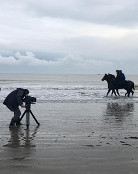Donn's Articles » Australia retires
Australia retires
It is always a source of regret among racing fans when a top class racehorse retires from racing. When that racehorse is as good a racehorse as Australia was, and still had the potential that Australia still had as a racehorse, that sense of regret is heightened.
Australia was high-profile even before he set foot on a racecourse. It wasn’t just that he was himself a son of two champion racehorses, by Galileo out of Ouija Board, but reports of impressive homework accompanied him to the racetrack for his debut at The Curragh on Irish Derby weekend in June last year.
Things did not go to plan that day. He was slow to leave the stalls, he gave his rivals a five-length start, he was green and gormless and he was beaten a neck. Three weeks later, same course and distance, he went back and got it right.
That win set the Aidan O’Brien-trained colt up for a juveniles’ Leopardstown showdown with Free Eagle, then the 2014 Derby favourite, in which Australia prevailed by six lengths. The feeling afterwards was that all had not been well with the beaten favourite, but it didn’t matter. Australia had won, and the Ballydoyle colt was the new talking horse and the new Derby favourite.
All the while, you were in no doubt about the regard in which Aidan O’Brien held the young colt. When the trainer said that this colt could be the best one that he had ever trained, your head went into a spin. Better than Galileo, better than Giant’s Causeway, better than Hawk Wing, better than Rock Of Gibraltar.
There was talk of Australia’s homework, talk of sub-11-second fractions, talk of five-furlong speed in a middle-distance horse’s body. Third in the 2000 Guineas on his first run as a three-year-old, he went and won the Epsom Derby on his second.
It was important that Australia won the Epsom Derby. He was bred to win it – by a Derby winner out of an Oaks winner – and he was backed to win it. He travelled best of all down the hill, wide off the rail, he moved easily up the home straight, picked up impressively at the two-furlong pole and stayed on well to hold off the persistent challenge of Kingston Hill. A measure of the quality of that performance lies in the fact that Kingston Hill won the St Leger last month and finished fourth in the Prix de l’Arc de Triomphe last Sunday from the widest draw of all.
It is a pity that Australia did not run in the Arc, Kingston Hill’s run tells you that he would have been a massive player in the race. He did win the Irish Derby easily in June, and he put up a really impressive performance to win the Juddmonte International at York in August, but he got beaten in the Irish Champion Stakes three weeks before the Arc.
That defeat has been well dissected at this stage. There were excuses. Nothing went right. He started out wide and he was forced wider. The early pace was frenetic and he made his ground into a quickening pace around the home turn. He was wide into the home straight before he succumbed to a sucker punch from The Grey Gatsby. And despite all that went wrong, he was still only beaten a neck by Kevin Ryan’s horse, a top class individual who had won the Dante and the Prix du Jockey Club earlier in the year.
Next Saturday’s British Champions Day at Ascot was always the target for Australia after his defeat in the Irish Champion Stakes. The Champion Stakes over 10 furlongs would have been the logical race for him, but there remained the intriguing prospect of dropping back down to a mile to run in the Queen Elizabeth II Stakes instead. Alas, an abscess in his foot meant that he was not going to make it to Ascot and, yesterday morning on The Morning Line on Channel 4, the decision to retire him from racing was announced.
It is a shame that Australia will not race on next year as a four-year-old. Of course, it is the owners’ prerogative. Commercial reality dictates. Frankel raced on at four, Prince Khalid Abdullah’s horse went unbeaten through his four-year-old year and he enriched the 2012 season. Sea The Stars did not, Sea The Stars retired after he won the Arc de Triomphe as a three-year-old in 2009, and the 2010 racing landscape was a poorer one for his absence.
Australia should have a successful career ahead of him as a Coolmore stallion. He has all the attributes that facilitate success as a stallion. But the majority of racing fans will be restricted to reading about him and waiting for his offspring, which we will not see race until 2018 at the earliest.
The Galileo colt will be remembered as a top class racehorse, a dual Derby winner. Timeform awarded him a rating of 132+, 4lb lower than Hawk Wing, so not Aidan O’Brien’s best ever. But the + is crucial, the potential for more. He could have been Aidan O’Brien’s best ever, there was probably more to come. The regret is that we will not now know how much more.
© The Sunday Times, 12th October 2014


 Follow Donn
Follow Donn